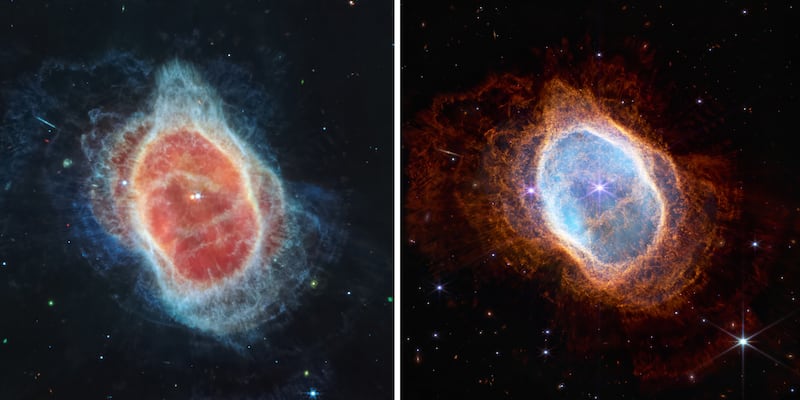A new image of the Ring Nebula has been released by the Nasa/ESA/CSA James Webb Telescope, with unprecedented detail.
The observations were released on Monday by an international team of scientists including Maynooth University’s experimental physics lecturer, Dr Patrick Kavanagh.
Dr Kavanagh led the data reduction and processing of the image taken by a mid-infrared instrument (MIRI), a camera and a spectrograph that sees light in the mid-infrared region of the electromagnetic spectrum, with wavelengths that are longer than human eyes can see.
The images show intricate details of structures and features, allowing scientists to understand their chemistry and how they were formed.
Actor Armie Hammer resurfaces as host of celebrity podcast
Heart-stopping Halloween terror: 13 of cinema’s greatest jump scares
Doctor Odyssey’s core message: just imagine Pacey from Dawson’s Creek holding you tight and saying, ‘Shhh, it’s okay’
Conor Niland’s The Racket nominated for William Hill Sports Book of the Year
“There has never been mid-infrared images of the Ring Nebula like this before. The exquisite detail reveals previously unknown features in the molecular halo that tell us this dying star’s nebula was likely shaped by an unseen companion star,” Dr Kavanagh said.

The new images provide unprecedented spatial resolution that show intricate details of the filament structure of the inner ring taken by NIRCam (Near-InfraRed Camera), and the concentric features of the outer regions of the nebulae’s ring taken by MIRI.
It is the equivalent of distinguishing the details of a soccer ball at a distance of 550km.
The images also provide insight on what the structures comprise and how they evolved. The images show some 20,000 dense globules in the nebula, which are rich in molecular hydrogen.
However, the inner region shows very hot gas, and the main shell contains a thin ring of enhanced emission from carbon-based molecules.
About 10 concentric arcs are located just beyond the outer edge of the main ring, that are thought to originate from the interaction of the central star with a low mass companion orbiting at a distance comparable to that between the Earth and the dwarf planet Pluto.
The colourful main ring is composed of gas thrown off by a dying star at the centre of the nebula. This star is on its way to becoming a white dwarf – a very small, dense, and hot body that is the final evolutionary stage for a star like the sun.
The Ring Nebula was discovered in 1779 by astronomers Antoine Darquier de Pellepoix and Charles Messier, and was added to the Messier Catalogue, who found it when trying to follow the path of a comet through the constellation of Lyra.
The observations were completed as part of the James Webb Space Telescope observing programme GO 1558. Webb is an international partnership between NASA, the European Space Agency and the Canadian Space Agency.





